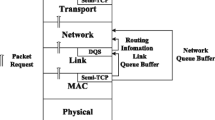Abstract
Next-generation networks (NGNs) will support quality of service over a mixed wired and wireless IP-based infrastructure. A relative model of service differentiation in differentiated services architecture is a scalable solution for delivering multimedia traffic. However, considering the dynamic nature of radio channels specifically, it is difficult to achieve a given service provisioning working at the IP and lower layers separately as in the classical approach without a run-time adaptation of the system towards the target quality. This work describes an IP cross-layer scheduler able to support a Proportional Differentiation Model (PDM) for delay guarantees also over wireless. The key idea is to leverage feedbacks from the lower layers about the actual delays experienced by packets in order to tune at run-time the priority of the IP service classes in a closed-loop control with the objective of supporting a PDM at the interface on the whole, considering the cumulative latency across multiple layers, as relevant for the end-user. A simulation analysis demonstrates the prominent improvements in reliability and robustness of the proposal in the case of time-variant performance of the MAC and PHY layers with respect to the classical non-cross-layer approach and open-loop control. Furthermore, considerations on the required functionality and likely deployment scenarios highlight the scalability and backward compatibility of the designed solution, addressing a sustainable approach and smooth migration to NGNs.





Similar content being viewed by others
References
ITU Y.2001. (2004). General overview of NGN.
Mustill, D., & Willis, P. J. (2005). Delivering QoS in the next generation network—a standards perspective. BT Technology Journal, 23(2), 48–60.
Blake, S., Black, D., Carlson, M., Davies, E., Wang, Z., & Weiss, W. (1998). An architecture for Differentiated Services. IETF Request for Comments (RFC 2475) http://www.ietf.org/rfc/rfc2475.txt
Nicholas, K., Blake, S., Baker, F., & Black, D. (1999). Definition of the Differentiated Services Field (DS Field) in the IPv4 and IPv6 Headers. IETF Request for Comments (RFC 2474)http://www.ietf.org/rfc/rfc2474.txt
Dovrolis, C., & Ramanathan, P. (1999). A case for relative Differentiated Services and the Proportional Differentiation Model. IEEE Network, 13(5), 26–34.
Dovrolis, C., Stiliadis, D., & Ramanathan, P. (2002). Proportional differentiated services: delay differentiation and packet scheduling. IEEE/ACM Transactions on Networking, 10(1), 12–26.
Lai, Y.-C., & Li, W.-H. (2003). A novel scheduler for proportional delay differentiation by considering packet transmission time. IEEE Communications Letters, 7(4), 189–191.
Simon, C., Vidacs, A., Moldovan, I., Torok, A., Ishibashi, K., Koike, A., & Ichikawa, H. (2002). End-to-end relative Differentiated Services for IP networks. In Proceedings of ISCC Seventh International Symposium on Computers and Communications (pp. 783–788).
Piri, E., Uitto, M., Vehkaperä, J., & Sutinen, T. (2010). Dynamic cross-layer adaptation of scalable video in wireless networking. In Proceedings of IEEE Global Telecommunications Conference (GLOBECOM 2010) (pp. 1–5).
Panza, G., & Grilli, S. (2013). An IP cross-layer scheduler for relative QoS support in NGNs. To be published in Proceedings of the IEEE Globecom 2013.
Szu, Y.-C. (2009). Using debt mechanism to achieve proportional delay and loss differentiation in a wireless network with a multi-state channel. In Proceedings of ISWPC 2009, 4th International Symposium on Wireless Pervasive Computing (pp. 1–6).
Yuan, X., Kai, C., & Nahrstedt, K. (2004). Distributed end-to-end proportional delay differentiation in wireless LAN. Proceedings of IEEE International Conference on Communications, 7, 4367–4371.
Levine, William S. (Ed.). (1996). The control handbook. New York: CRC Press. ISBN 978-0-8493-8570-4.
Hossain, M., Hassan, M., & Sirisena, H. R. (2004). Adaptive resource management in multi-service mobile wireless cellular networks using feedback control. In Proceedings of the IEEE 60th Vehicular Technology Conference (vol. 6, pp. 3984–3988).
Kabamba, P. T., Meerkov, S. M., Stark, W. E., & Tang, C. Y. (2001). Feedforward control of data rate in wireless networks. In Proceedings of the 40th IEEE Conference on Decision and Control (vol. 2, pp. 1043–1048).
Zhou, H., Hoang, D., Nhan, P., & Mirchandani, V. (2004). Introducing feedback congestion control to a network with IEEE 802.11 wireless LAN. In Proceedings of the IEEE wireless telecommunications symposium (pp. 61–66).
Åström K. J., & Hägglund, T. (1995). PID controllers.
Chen, J. L., & Chen, N. K. (2007). Feedback QoS control scheme for wireless network applications. Elsevier Computer and Electrical Engineering.
Wu, D., & Negi, R. (2003). Effective capacity: A wireless link model for support of quality of service. IEEE Transactions on Wireless Communication, 2, 630–643.
Chang, Cheng-Shang, & Thomas, J. (1995). Effective bandwidth in high speed digital networks. IEEE Journal on Selected Areas in Communications, 13, 1091–1100.
Heinanen, J., Baker, F., Weiss, W., & Wroclawski, J. (1999). Assured forwarding PHB group. IETF Request for Comments (RFC 2597)http://www.ietf.org/rfc/rfc2597.txt
www.riverbed.com/us/products/cascade/wireshark_enhancements/airpcap.php
GPP TS 36.300 v. 8.11.0 (2010). Evolved Universal Terrestrial Radio Access (E-UTRA) and Evolved Universal Terrestrial Radio Access (E-UTRAN); Overall Description; Stage 2.
GPP TS 23.203 v. 8.8.0 (2009). Policy and charging control architecture.
Umlauft, M., & Reichl, P. (2009). Getting network simulation basics right—a note on seed setting effects for the ns-2 random number generator. Lecture Notes in Electrical Engineering, 44, 215–228.
Acknowledgments
This work has been carried out within the framework of the IST CONCERTO project, partially supported by the European Commission under the Contract FP7 No. INFSO-ICT-288502.
Author information
Authors and Affiliations
Corresponding author
Rights and permissions
About this article
Cite this article
Panza, G., Grilli, S. An IP cross-layer scheduler with closed-loop control for QoS provisioning in NGNs. Wireless Netw 21, 1985–1997 (2015). https://doi.org/10.1007/s11276-015-0901-8
Published:
Issue Date:
DOI: https://doi.org/10.1007/s11276-015-0901-8




